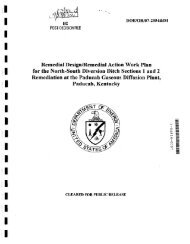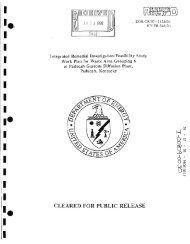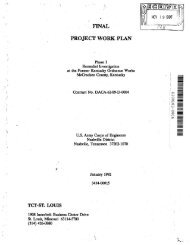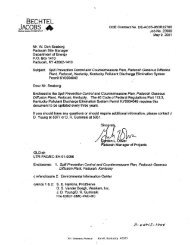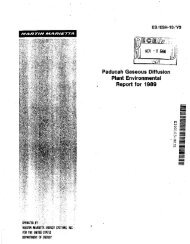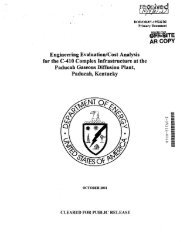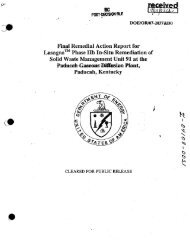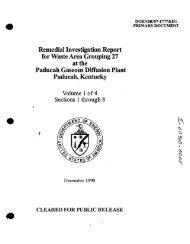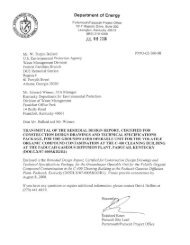1 - paducah environmental information center
1 - paducah environmental information center
1 - paducah environmental information center
You also want an ePaper? Increase the reach of your titles
YUMPU automatically turns print PDFs into web optimized ePapers that Google loves.
Paducah Site<br />
activities. This infonnation is· essential to<br />
characterize atmospheric transport and diffusion<br />
conditions in the vicinity of the Paducah Site.<br />
On-site meteorological data are used as<br />
input to calculate radiation dose to the public<br />
(see Section 6). Additional meteorological data<br />
from Barkley Regional Airport are used by some<br />
groups; For example, the Environmental<br />
Restoration Program uses this data to correlate<br />
precipitation with groundwater flow.<br />
Computer-aided atmospheric dispersion<br />
modeling uses emission and meteorological data<br />
to determine the impacts of plant operations.<br />
Modeling is used to simulate the transport of air<br />
contaminants and to predict the effects of<br />
abnonnal airborne emissions from a given<br />
source. In addition, a multitude of emergency<br />
scenarios can be developed to estimate the<br />
effects of unplanned releases on employees and<br />
popUlation <strong>center</strong>s downwind of the source.<br />
Ohio River (L 29), downstream Ohio River (L<br />
30), downstream in the Ohio River at the<br />
confluence with the Mississippi River (L 306),<br />
and reference stream Massac Creek (L 64). No<br />
sample point exists for upstream Little Bayou<br />
Creek as the watershed is insufficient to develop<br />
adequate flow to monitor. Nearly all water in<br />
Little Bayou Creek is comprised of discharges<br />
from· plant outfalls. Therefore, background<br />
water quality for Little Bayou Creek is based on<br />
L I (upstream Bayou Creek). L 29 and L 64 are<br />
reference waterways also used for comparisons<br />
with data for Little Bayou Creek surveillances.<br />
Figure 5.1 shows all surface water sampling<br />
locations, including those used only for<br />
nonradiological sampling (Section 8). Table 5.1<br />
shows the radiological analytical parameters.<br />
Surface Water Surveillance Results<br />
Table 5.2 reflects the average concentrations<br />
of radionuclides present upstream and<br />
downstream of plant effluents in Bayou Creek<br />
Surface Water<br />
All Paducah Site surface water runoff is<br />
released either to the west to Bayou Creek or to<br />
the east to Little Bayou Creek via plant outfalls.<br />
Bayou and Little Bayou creeks merge north of<br />
the site and discharge into the Ohio River. The<br />
net impact of the Paducah Site on ·surface waters<br />
can be evaluatoo by comparing data from<br />
samples collected upstream of the site with data<br />
from samples collected downstream of the site or<br />
from reference waterways. Bayou and Little<br />
Bayou· Creeks are considered to be waters of the<br />
Commonwealth of Kentucky and designated for<br />
all uses by the Commonwealth. However,<br />
because these creeks are not used as drinking<br />
water supplies, EPA safe drinking water<br />
standards do not apply. Radioactive effluents<br />
are controlled via DOE Order 5400.5.<br />
Bimonthly radiological sampling is<br />
conducted at upstream Bayou· Creek (L 1),<br />
downstream Bayou Creek (L 5), downstream<br />
Little Bayou Creek (L 10 and L 11), upstream<br />
'L306<br />
t;:::::)<br />
A CRA\\fORD<br />
~~<br />
I.<br />
a<br />
I<br />
U<br />
BAllARD co.<br />
McCRACJ(EN co.<br />
3KM<br />
Surface 'M:JIer SamplIng<br />
a 2 MILES PIlInt<br />
Figure 5.1 Surface water monitoring locations.<br />
5-2<br />
Radiological Environmental Surveillance



